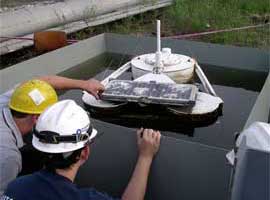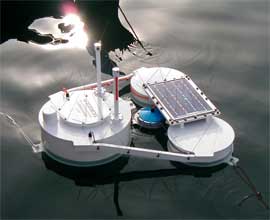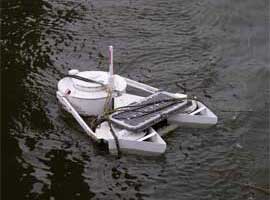
detecting floating hydrocarbons in marine applications.
Shale Gas Industry Home GE Leakwise Home
 |
The ID-227WL is a wireless sensor for detecting floating hydrocarbons in marine applications. |
The Leakwise ID-227WL Sensor is designed for installation at offshore oil tanker buoy terminals, jetties, and piers to detect floating oil sheens resulting from spills or leaks occurring during the loading and offloading process. Additional applications include detecting and monitoring floating hydrocarbons in lagoons, lakes, rivers, open channels, large retention ponds, and near offshore oil rigs.
Description
The ID-227 System consists of a wave rider float incorporating:
The wave rider float is designed to maintain the position of the detecting antenna at the liquid/air interface, despite fluctuations in the water level due to waves and tide. It has two field adjustable alarm points:
The WSP-220 Digital Wireless Sensor Controller is built into the ID-227WL.
 |
The Leakwise ID-227WL system incorporates an oil detection sensor, integrated wireless controller, wireless communication antennas, and a solar panel with battery. |
Features and benefits of the Leakwise ID-227WL Wireless Oil-on-Water Monitoring Sensor include:
 |
The Leakwise ID-227WL can detect 0.3 to 20 mm of hydrocarbon on water or brine. |
System specifications for the Leakwise ID-227WL Wireless Oil Sheen Monitoring System for marine applications:
| Sensor Operating Range |
| Detection Range 0.3–20 mm (0.01–0.79 in) of hydrocarbon on water or brine Working Wave Height Maximum 2 m (6.6 ft) Tide Range Unlimited, depending on mooring method Current Up to 4 knots (6.8 ft/sec); for higher current — consult factory Minimum Liquid Depth 15 cm (~6 in) Working Temperature 0° to 50° C (32° to 172º F) Survival Conditions Extreme sea conditions, depending on appropriate mooring |